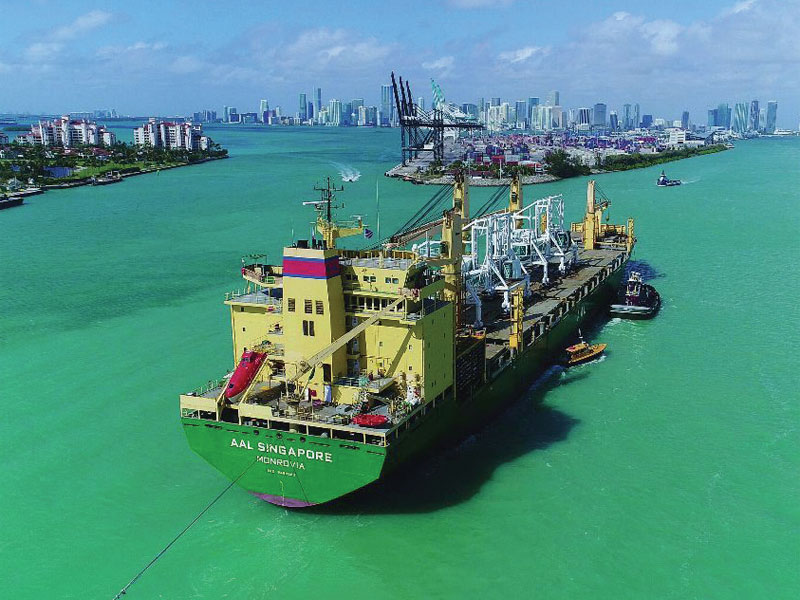With container vessels stuffed to capacity, breakbulk cargoes are returning to breakbulk carriers.
The breakbulk shipping segment has been in the doldrums in recent years, but the sector may be poised for a rebound in 2021. Breakbulk cargoes, which are carried in crates and bags, on pallets, or—as is the case with project cargo—lifted on and off vessels have faced a myriad of challenges.

Like the container business until recently, the multipurpose vessel fleet has suffered from an overcapacity that has led to downward pressure on rates, and that has turned up the heat on competition. But after several years of a supply glut, capacity began tightening up last year.
“The last ten years have been tough ones for multipurpose vessel operators,” said Michael Morland, General Manager Americas at AAL Shipping in Houston. “With increased competition and an oversupply in the market, some vessels are now leaving market, which is a good sign.”
Over the last six months, the multipurpose vessel segment has been able to command higher rates. “The container market has been in a squeeze and overflow cargo has been going to multipurpose vessels,” said Morland. “That has pushed rates upwards and I suspect that will continue in 2021.”

The container squeeze resulted from spiking demand for Asian goods beginning in July 2020, thanks to pent-up demand in the aftermath of the easing of the COVID-19 shutdowns. Drewry estimated that global container port throughput declined almost 6% in the first half of 2020, and then boomed over 10% through the final six months of the year. That boom is continuing into 2021.
Two Impacts on MPPs
These conditions have had two effects, according to Morland. “One is that some cargo that previously migrated from breakbulk to containers is no longer doing that,” he said, and the cargo migrating back to breakbulk is likely to stay there. “Shippers are creatures of habit,” Morand added, “and it’s easier for them to keep doing what they are doing. We anticipate that some of this cargo will stay with us.”
The cargoes migrating back from containers include forestry products and small to mid-sized project pieces. “Especially when containers are expensive,” said Morland, “it defeats the purpose to stow these types of cargoes in boxes.”
The other effect of the container squeeze is that general container cargo is now being carried on AAL multipurpose vessels. But Morland considers this a “temporary situation” that probably won’t last beyond this year. “But we will be providing that service as long as the market wants us to,” he added.
As a result of changes in the marketplace, AAL has committed additional tonnage and resources to strengthening the Asia-to-Americas trade lane in 2021. The carrier recently announced that it is enhancing a tramp service that connects Southeast Asia, the Far East, the U.S. Gulf Coast, and the US East Coast with a commitment that involves at least one sailing a month and employing multiple vessel types. AAL’s fleet comprises various sizes of heavy lift multipurpose vessels, that can carry cargo of up to 40,000 cubic meters and heavy lift of 700 tons. Two-thirds of its vessels fall into the mega size MPV segment, of 30,000 or more dead-weight tons.
“We are noticing a slow shift towards more project cargo influence from Asia,” said Morland, noting that project cargo like renewables and liquefied natural gas projects into the U.S. Gulf were normally booked from within the U.S. “A lot of the smaller cargoes tend to be booked at origin in Asia,” he added.
Factory construction, power generation, and heat recovery systems projects, along with energy and renewables, are among the cargoes that are expected to be carried on the service. AAL has also seen an increase in smaller cargoes that are frequenting the Asia-to-Americas trade lane since the beginning of this year thanks in part to some of the players leaving the breakbulk segment in 2020. Further into 2021, AAL is forecasting increased cargo volumes from Asia to South America.
In addition to cargo originating in Asia, AAL also delivers cargoes to the Americas originating in Europe. These are collected on a separate Europe-to-Asia service and deposited in Asia for onward transport from Shanghai. The service also sometimes calls on Japanese ports before crossing the Pacific Ocean.
Cargoes outbound from the U.S. include bulk commodities such as iron ore, pet coke, and wood pulp and other forestry products going to “a mix of Asian ports,” said Morland, most notably in Japan and China. AAL’s multipurpose ships can be reconfigured to carry bulk commodities with the use of retractable tween decks that split the cargo hold and allow the ship to carry different cargoes on different levels, including bulk cargo beneath the tween decks. AAL also carries yachts outbound from the U.S. to ports in Canada and Mexico.
The ramped-up service came about “because, as a global carrier with a fleet of 25 or so vessels, we have to prioritize fleet allotments,” said Morland. “Where we see opportunities, we allocate more tonnage.” Houston will serve as the primary port of call for the enhanced service, with New Orleans, Mobile, Charleston, Savannah, and Altamira, Mexico, also serving as likely destinations. Morland expects the AAL service also to call on Norfolk and Philadelphia upon request.
AAL’s bullishness on the Asia-to-Americas trade also hangs on anticipated changes that will come with the new administration in Washington. Morland foresees that the Biden administration will continue a strict line on trade with China, but anticipates a more constructive dialogue that will lead to increased trade volumes between the two countries.




